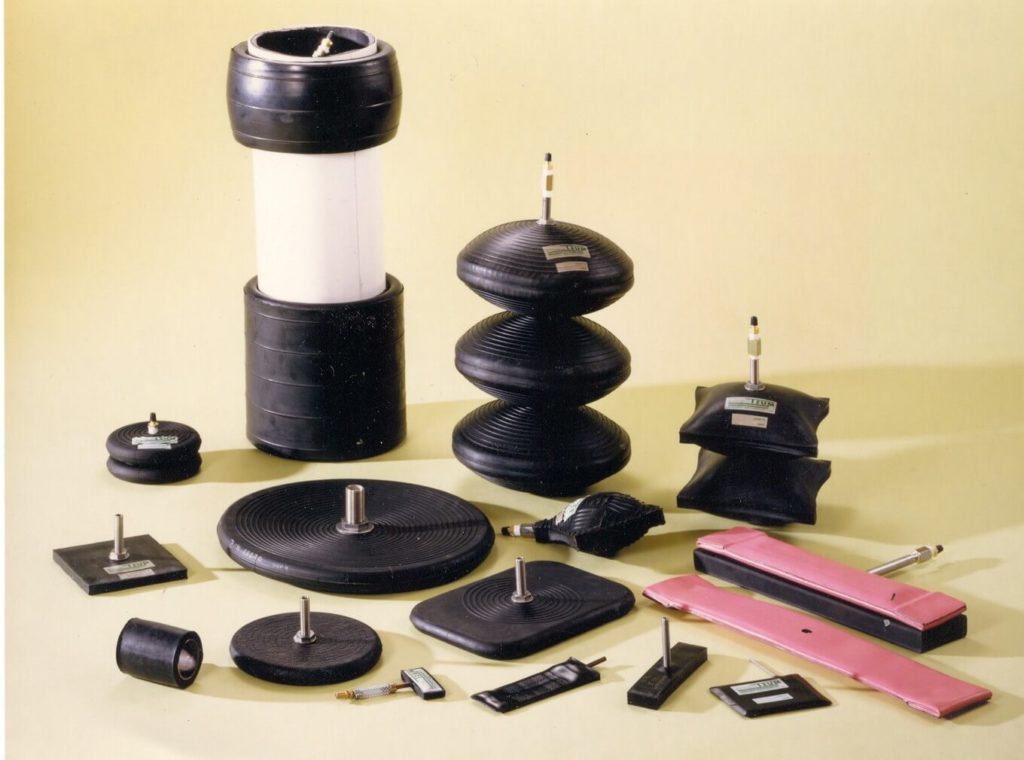What is a pneumatic cylinder?
Pneumatic cylinders are a piece of equipment that uses compressed air to create linear or rotary motion.
The most popular air cylinders are pneumatic actuators with piston.
Find out which pneumatic cylinders offer the most benefits: inflatable pneumatic cylinders.
Here’s why:
Advantages of the inflatable pneumatic cylinder (IPC) / piston pneumatic cylinder (PPC)
+ Minimum thickness of the inflatable pneumatic cylinder < cylinder stroke.
The minimum thickness of an inflatable cylinder (air jack) is less than the stroke it develops unlike the piston pneumatic cylinder (PPC).
EX : to have a 100mm stroke, the PPC must have a minimum thickness of 120mm; for an IPC the minimum thickness will be 20mm as standard.
+ Dimensions of the inflatable pneumatic cylinder = support surface
The diameter of the piston determine the overall dimensions of a PPC . On a IPC, however, the shape can be adapted to the required support surface.
EX: for an active surface requirement of 120mm2, a PPC will have a footprint of at least 150mm2 whereas on a IPC it will have a footprint of 120mm2.
+ Possible superposition of inflatable pneumatic cylinders
It is possible to manufacture multi-stage IPCs. This allows to increase the stroke for a space that remains limited. This is not possible with the PPC.
+ Simple & quick installation of the inflatable pneumatic cylinders
Use the pneumatic connection to fix the IPCs, so a single attachment point. PPCs, on the other hand, require several attachment points, often 8 or more, which makes them more complex to install. In addition, the PPC require an alignment system (groove) unlike the IPCs.
+ Variety of shapes of inflatable pneumatic cylinders
Thanks to their manufacturing technique, we can manufacture the IPCs in multiple shapes: square, rectangular, round, toric…. We will choose the shape that best suits the constraints of use. The PPCs, on the other hand, have only one shape.
+ Optimal force/pressure ratio of inflatable pneumatic cylinders
For the same power and the same size, the IPC will develop a much higher thrust than the PPC.
EX : an air cylinder with a 150 x 150mm foot print(diam.120mm of piston) will develop a thrust of 900kg whereas an IPC with a 150 x 150mm foot print will develop a thrust of 1500kg with the same pressure of use (8 bar).
+ Easy adaptation to hostile environments with inflatable pneumatic cylinders
The IPC are used in a wider temperature range (-50°C to +100°C) than the PPC (-20°C +70°C). They also accept working in a dusty environment, or one that is subjected to radiant heat or a humid environment or an environment with vibrations, so many constraints not tolerated by the PPC. They are ATEX by nature which is an option for PPCs
+ No maintenance for inflatable pneumatic cylinders
The IPCs do not require any maintenance unlike the PPCs (lubrication…)
+ No corrosion for inflatable pneumatic cylinders
IPCs do not suffer from corrosion because we manufacture them with rubber complex. Unlike PPC’s which are made of metal.
+ Multiple energy sources for inflatable pneumatic cylinders
You can use multiple energy sources to operate an IPC (water, oil, air …) unlike PPCs that only use air.
and FINALLY THE PLUS of the INFLATABLE PNEUMATIC CYLINDER: Uniform pressure distribution
The huge advantage of the IPC is to have a very large active surface and a distribution of power over the entire surface unlike the PPC which has an active surface limited to the piston surface. With the IPC technique it is easy to obtain an active surface of SEVERAL M2.
